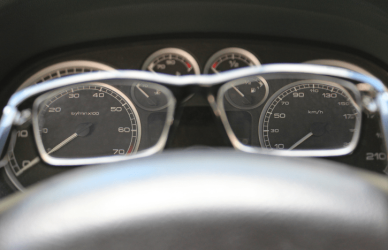In a recent Twitter thread, Tomasz Orynski, a Polish freelance journalist, blogger, podcaster, and longtime professional truck driver, gave his thoughts on the cab design of the new Tesla semi truck. Without going into mechanical specifics, carrying capacity, mileage, or charging, Orynski’s thread points out, from a driver’s point of view, why the cab design makes the new rig a “completely stupid vehicle.”
Tesla said of their cabin that they have “built it around the driver,” but Orynski gave several examples as to why the cab current cab design lacks usability for drivers.
In the thread, Orynski starts by talking about the central seating position. According to the trucker, this setup not only wastes space, but also presents some safety and usability concerns. He stated that the central driving position makes it more challenging to look ahead when trying to pass because your position within the wide vehicle puts you too far from the edge of the lane to see oncoming traffic.
He also points out that drivers need to pay tolls, talk with gatehouse attendants, and handle paperwork when entering docks or making deliveries. The positioning doesn’t give access to a window, and, in fact, the windows can’t be opened, so the driver will have to leave their seat, open the door, and get out for such interactions.
Orynski went on to discuss the usability issues of the door placement. Having the doors at the back of the cab means the driver will have to walk several steps to reach their seat. In wet, snowy, or muddy weather, this means the mess gets tracked through the cab, whereas doors with direct access to the driver’s seat allow drivers to keep the mess contained.
In addition, he points out, this door placement also doesn’t allow for a bed in the cab. He states that even if the vehicle was not conceived for long trips, that people driving at night often find it useful to take a quick nap to continue driving safely.
The truck driver also points out his personal distaste for the massive screens inside the truck. He feels that the “tablets are simply not designed for use in moving vehicles,” stating that drivers need physical buttons that they can reach without taking their eyes off the road. He goes on to say that during daytime driving, they reflect too much and at night, even in dark mode, they produce too much glow.
Orynski moved on to address the side-view mirrors, which due to the central driver’s seat and narrower front, are placed on rather long arms. He points out if they get dirty, (and eventually they will) the driver can not easily reach them to clean them.
Last, the trucker discusses the potential issues of the bullet shape cab with its angled windshield. According to Orynski, this design will collect snow in winter, and that due to the positioning, snow collected on the windshield will be difficult to remove, an issue not shared with vertical windshields. He also pointed out that windshield design will turn the cab into a very warm greenhouse on sunny summer days.
“I can go on. [The] bottom line is that this vehicle is a rich boy’s toy, not a practical, working vehicle because its designers have no clue about the realities of transport,” wrote Orynski.
You can read the entire Twitter thread HERE.








